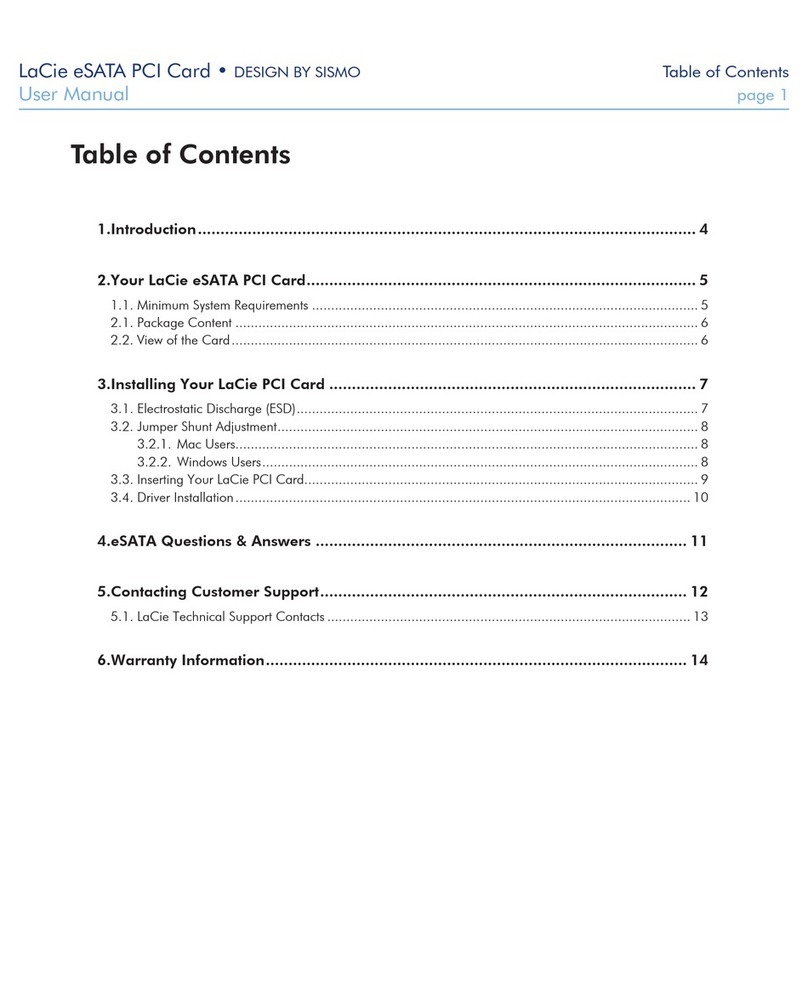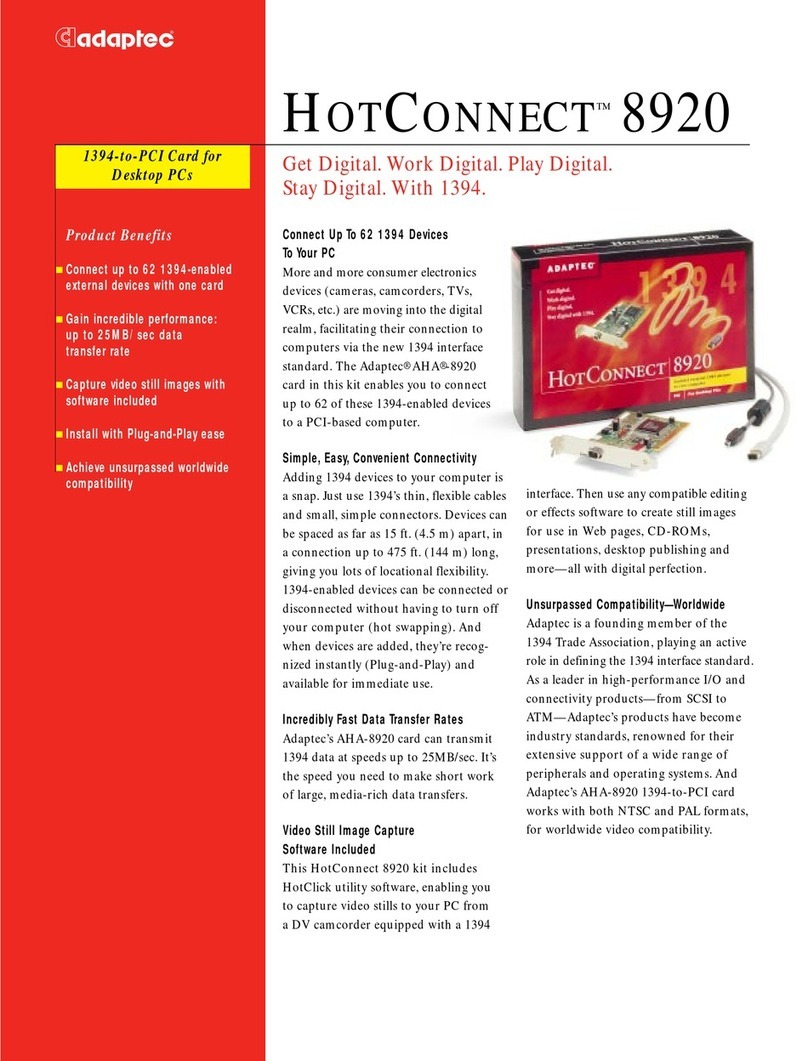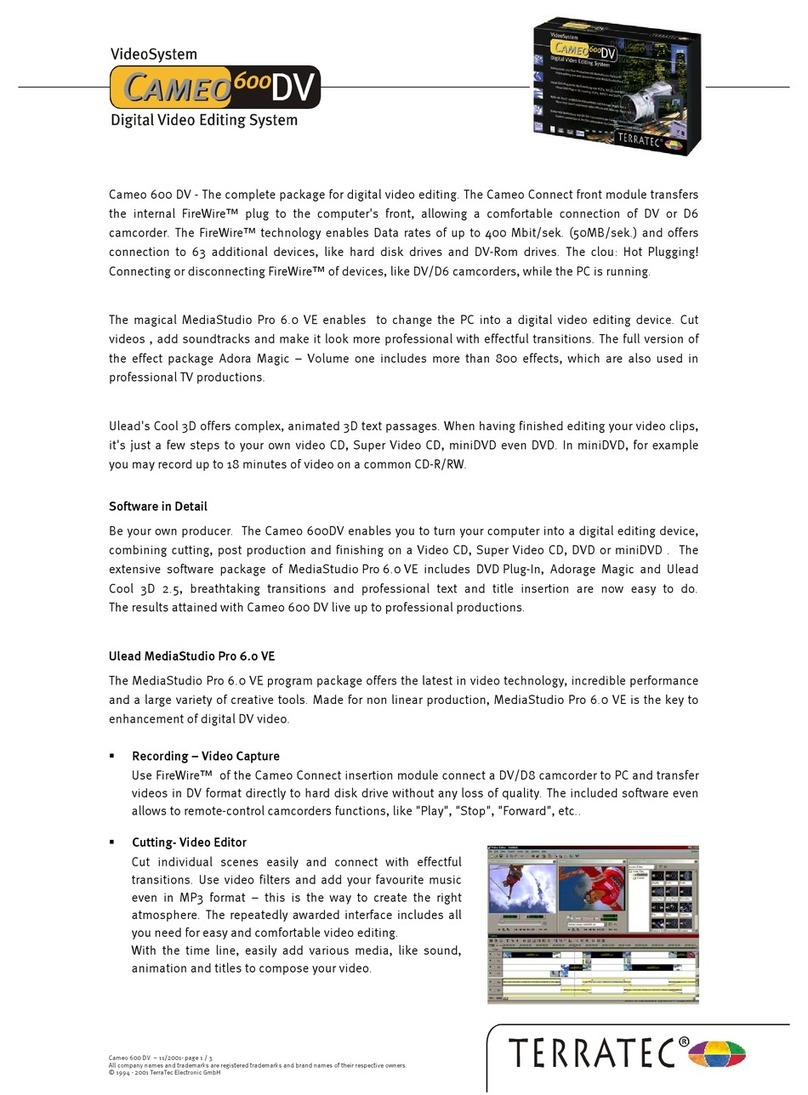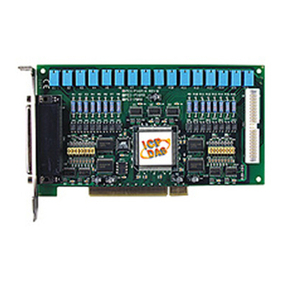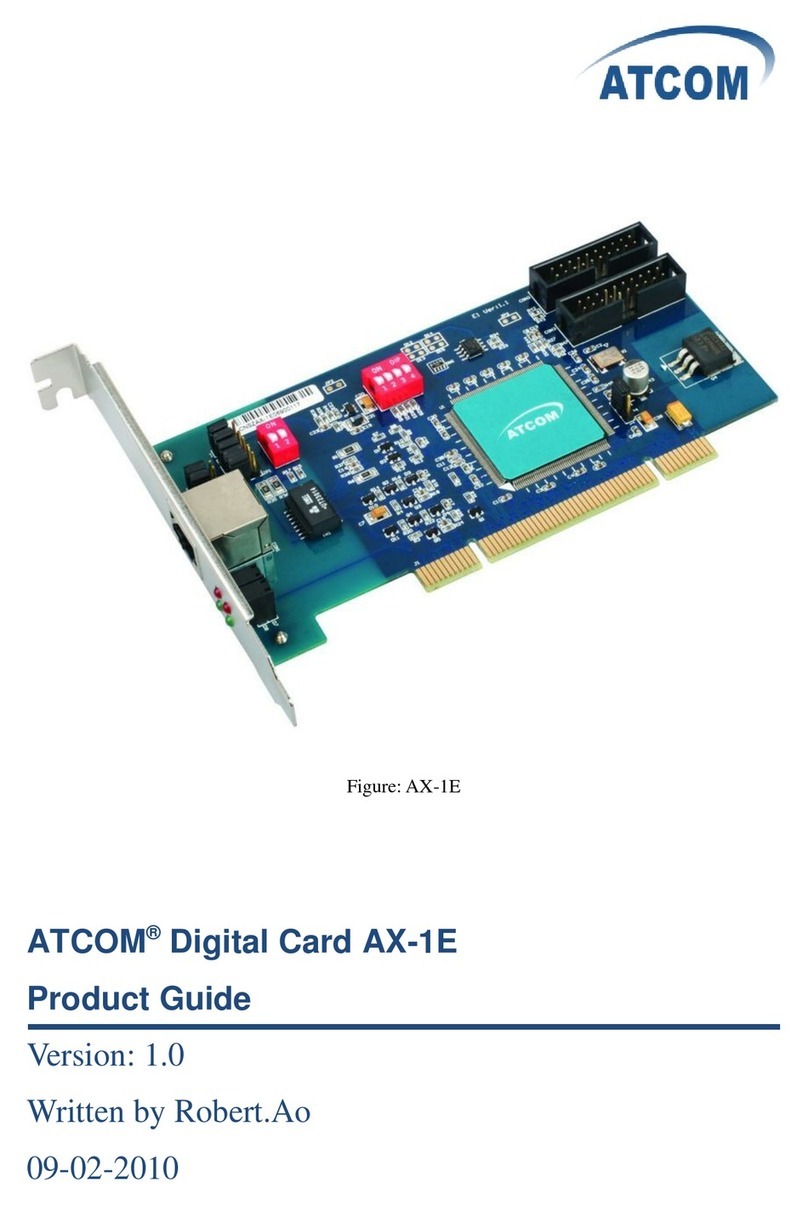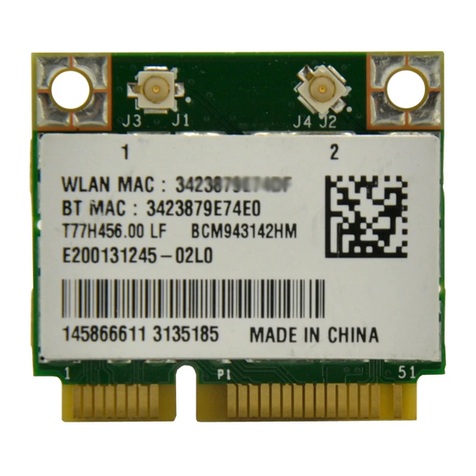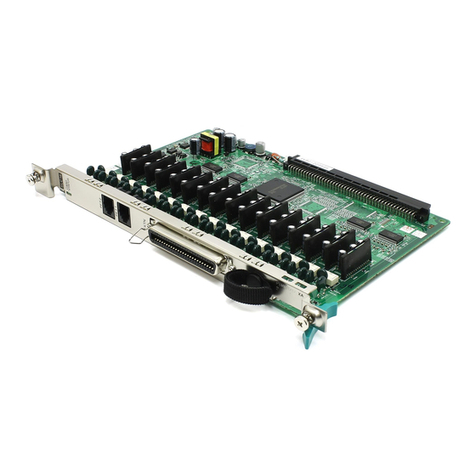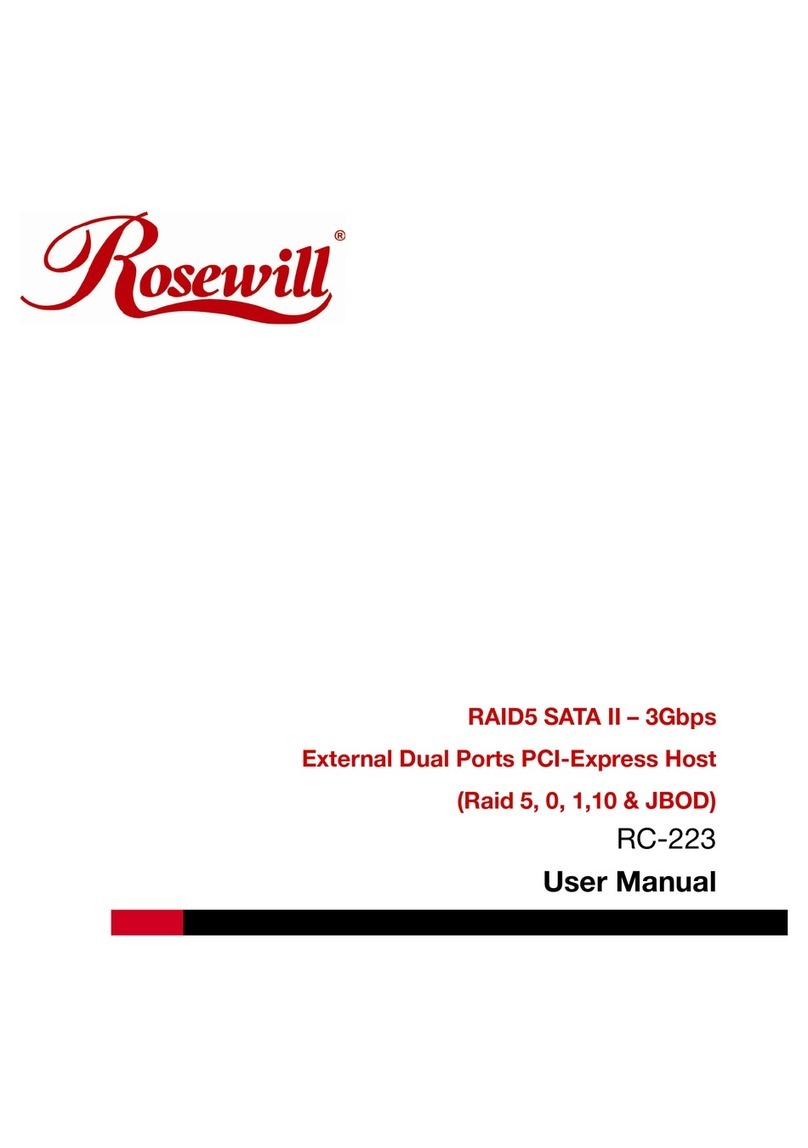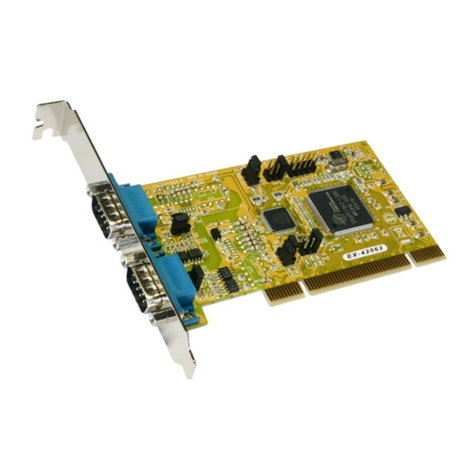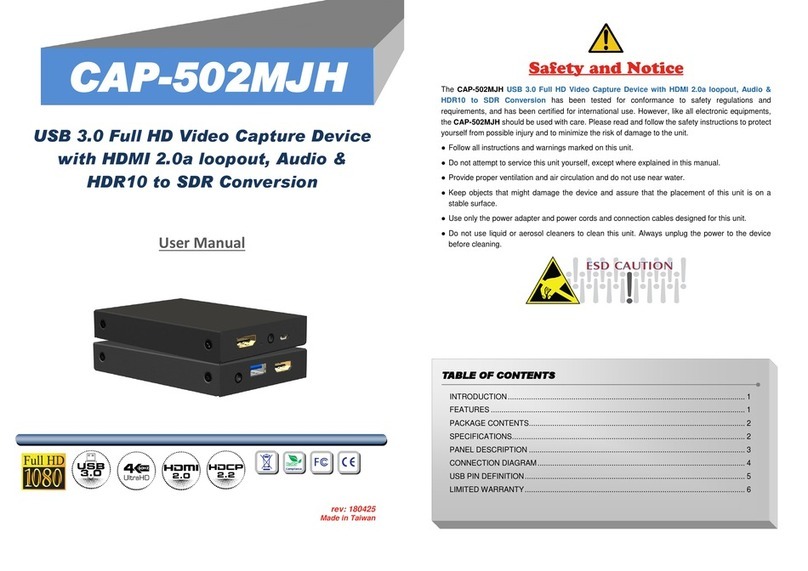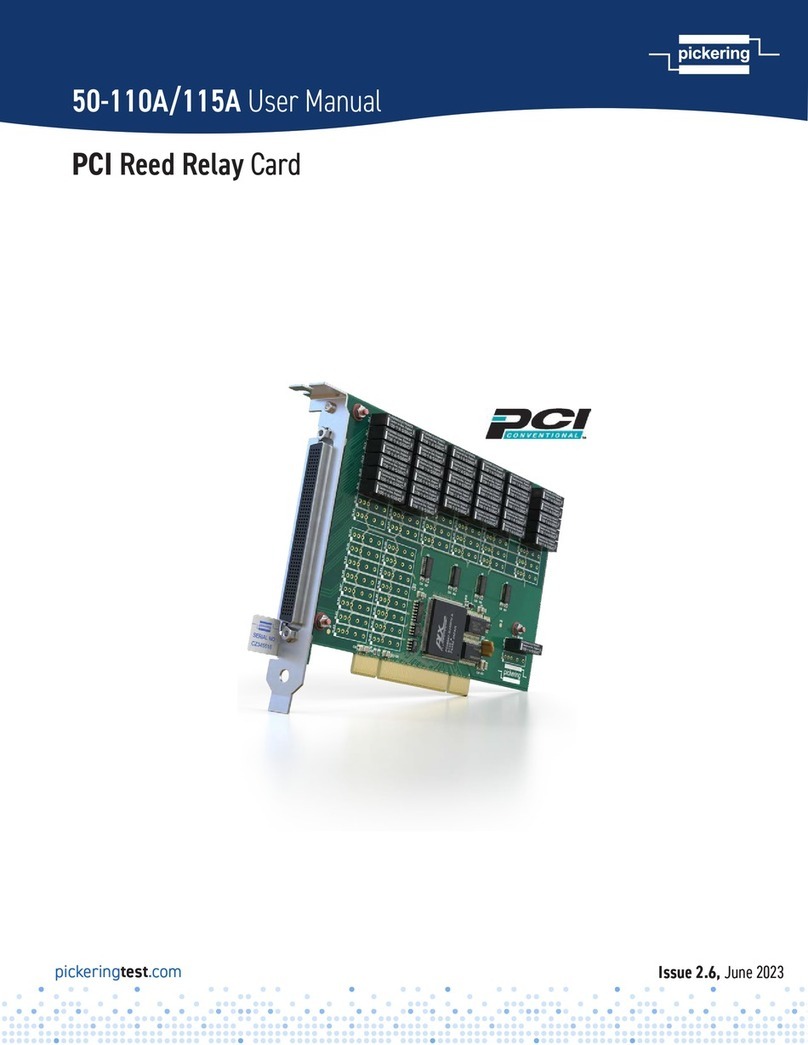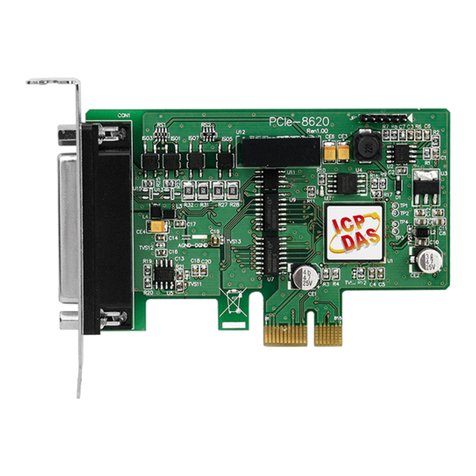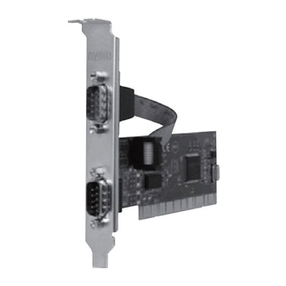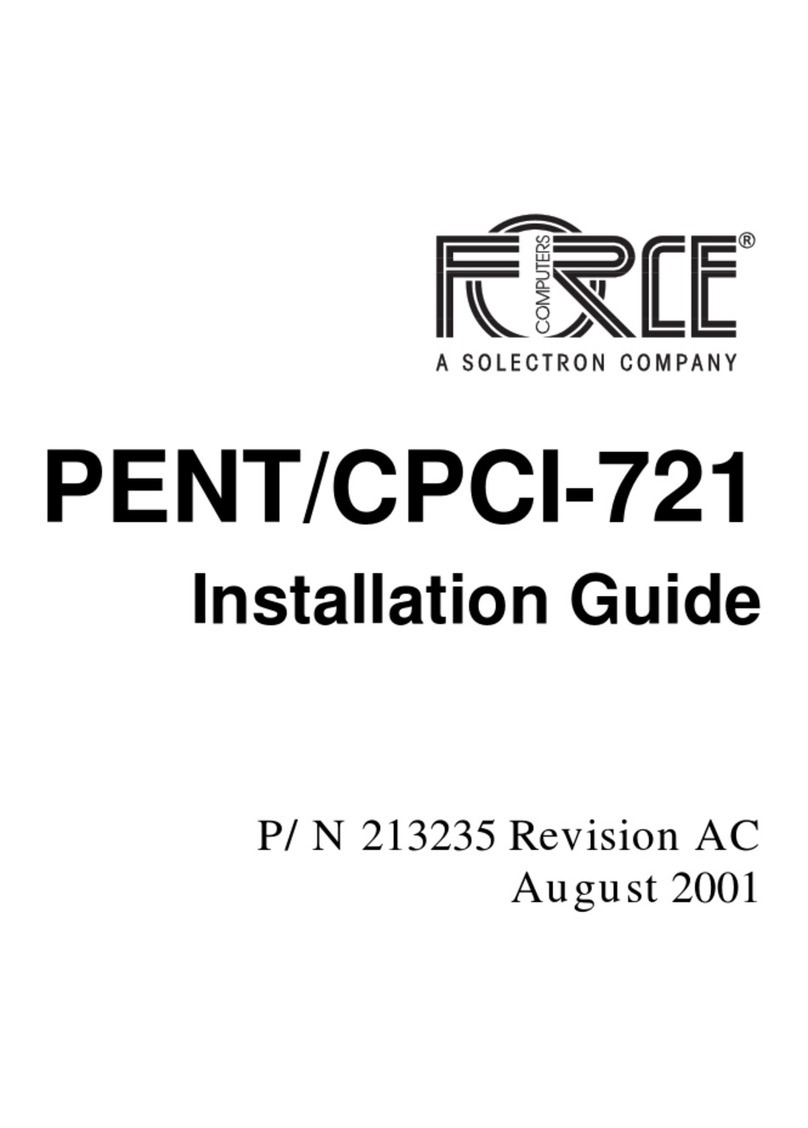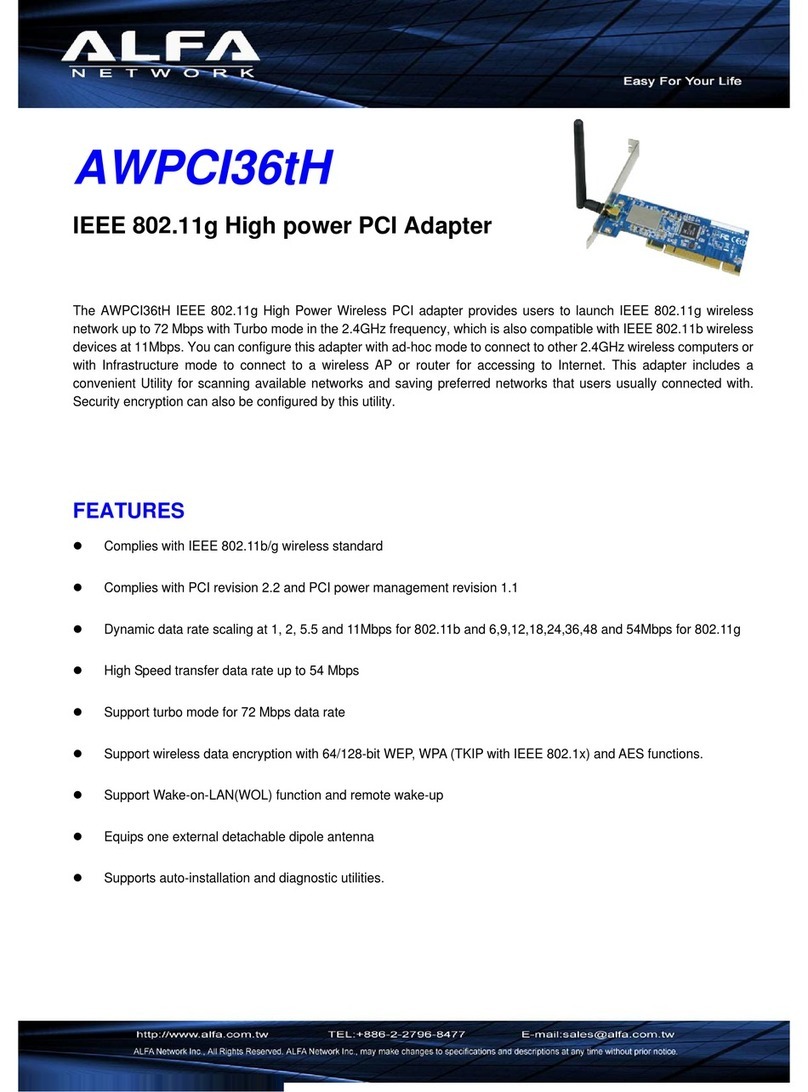Data Translation DT300 Series User manual

DT300 Series
UM-16501-T
User’s Manual
Title Page

Seventeenth Edition
April, 2010
Data Translation, Inc.
100 Locke Drive
Marlboro, MA 01752-1192
(508) 481-3700
www.datatranslation.com
Fax: (508) 481-8620
E-mail: [email protected]
Copyright © 1997 - 2010 by Data Translation, Inc.
All rights reserved.
Information furnished by Data Translation, Inc. is believed to be
accurate and reliable; however, no responsibility is assumed by
Data Translation, Inc. for its use; nor for any infringements of
patents or other rights of third parties which may result from its
use. No license is granted by implication or otherwise under any
patent rights of Data Translation, Inc.
Use, duplication, or disclosure by the United States Government
is subject to restrictions as set forth in subparagraph (c)(1)(ii) of
the Rights in Technical Data and Computer software clause at 48
C.F.R, 252.227-7013, or in subparagraph (c)(2) of the Commercial
Computer Software - Registered Rights clause at 48 C.F.R.,
52-227-19 as applicable. Data Translation, Inc., 100 Locke Drive,
Marlboro, MA 01752.
Data Translation® is a registered trademark of Data Translation,
Inc. DT-Open LayersTM, DT-Open Layers for .NET Class
LibraryTM, Data Acq SDKTM, Data Acquisition OMNI CDTM,
LV-LinkTM, and DTx-EZTM are trademarks of Data Translation,
Inc.
All other brand and product names are trademarks or registered
trademarks of their respective companies.
Copyright Page

Radio and Television Interference
This equipment has been tested and found to comply with CISPR EN55022 Class A and
EN50082-1 (CE) requirements and also with the limits for a Class A digital device, pursuant to
Part 15 of the FCC Rules. These limits are designed to provide reasonable protection against
harmful interference when the equipment is operated in a commercial environment. This
equipment generates, uses, and can radiate radio frequency energy and, if not installed and
used in accordance with the instruction manual, may cause harmful interference to radio
communications. Operation of this equipment in a residential area is likely to cause harmful
interference, in which case the user will be required to correct the interference at his own
expense.
Changes or modifications to this equipment not expressly approved by Data Translation
could void your authority to operate the equipment under Part 15 of the FCC Rules.
Note: This product was verified to meet FCC requirements under test conditions that
included use of shielded cables and connectors between system components. It is important
that you use shielded cables and connectors to reduce the possibility of causing interference
to radio, television, and other electronic devices.
Canadian Department of Communications Statement
This digital apparatus does not exceed the Class A limits for radio noise emissions from
digital apparatus set out in the Radio Interference Regulations of the Canadian Department of
Communications.
Le présent appareil numérique n’émet pas de bruits radioélectriques dépassant les limites
applicables aux appareils numériques de la class A prescrites dans le Règlement sur le
brouillage radioélectrique édicté par le Ministère des Communications du Canada.
FCC
Page


5
Table of Contents
About this Manual . . . . . . . . . . . . . . . . . . . . . . . . . . . . . . . . . . . . . . . . . . . . . . . . . . . . . 11
Intended Audience. . . . . . . . . . . . . . . . . . . . . . . . . . . . . . . . . . . . . . . . . . . . . . . . . . . . . . . . . . . . 11
How This Manual is Organized . . . . . . . . . . . . . . . . . . . . . . . . . . . . . . . . . . . . . . . . . . . . . . . . . 11
Conventions Used in this Manual . . . . . . . . . . . . . . . . . . . . . . . . . . . . . . . . . . . . . . . . . . . . . . . 12
Related Information . . . . . . . . . . . . . . . . . . . . . . . . . . . . . . . . . . . . . . . . . . . . . . . . . . . . . . . . . . . 12
Where To Get Help. . . . . . . . . . . . . . . . . . . . . . . . . . . . . . . . . . . . . . . . . . . . . . . . . . . . . . . . . . . . 13
Chapter 1: Overview . . . . . . . . . . . . . . . . . . . . . . . . . . . . . . . . . . . . . . . . . . . . . . . . . . . 15
Features . . . . . . . . . . . . . . . . . . . . . . . . . . . . . . . . . . . . . . . . . . . . . . . . . . . . . . . . . . . . . . . . . . . . . 16
Supported Software . . . . . . . . . . . . . . . . . . . . . . . . . . . . . . . . . . . . . . . . . . . . . . . . . . . . . . . . . . . 18
Accessories . . . . . . . . . . . . . . . . . . . . . . . . . . . . . . . . . . . . . . . . . . . . . . . . . . . . . . . . . . . . . . . . . . 19
Getting Started Procedure. . . . . . . . . . . . . . . . . . . . . . . . . . . . . . . . . . . . . . . . . . . . . . . . . . . . . . 20
Part 1: Getting Started . . . . . . . . . . . . . . . . . . . . . . . . . . . . . . . . . . . . . 21
Chapter 2: Installing the Board and Loading the Device Driver . . . . . . . . . . . . . . . . 23
Unpacking . . . . . . . . . . . . . . . . . . . . . . . . . . . . . . . . . . . . . . . . . . . . . . . . . . . . . . . . . . . . . . . . . . . 25
Setting up the Computer . . . . . . . . . . . . . . . . . . . . . . . . . . . . . . . . . . . . . . . . . . . . . . . . . . . . . . . 26
Setting up an Expansion Slot . . . . . . . . . . . . . . . . . . . . . . . . . . . . . . . . . . . . . . . . . . . . . . . . . . . 27
Loading the Device Driver . . . . . . . . . . . . . . . . . . . . . . . . . . . . . . . . . . . . . . . . . . . . . . . . . . . . . 29
Windows XP. . . . . . . . . . . . . . . . . . . . . . . . . . . . . . . . . . . . . . . . . . . . . . . . . . . . . . . . . . . . . . 29
Windows Vista. . . . . . . . . . . . . . . . . . . . . . . . . . . . . . . . . . . . . . . . . . . . . . . . . . . . . . . . . . . . 29
Windows 7 . . . . . . . . . . . . . . . . . . . . . . . . . . . . . . . . . . . . . . . . . . . . . . . . . . . . . . . . . . . . . . . 30
Chapter 3: Attaching and Configuring a Screw Terminal Panel/ Backplane . . . . . . 31
Using an STP300 Screw Terminal Panel . . . . . . . . . . . . . . . . . . . . . . . . . . . . . . . . . . . . . . . . . . 33
Attaching an STP300 Screw Terminal Panel . . . . . . . . . . . . . . . . . . . . . . . . . . . . . . . . . . . 33
Configuring an STP300 Screw Terminal Panel . . . . . . . . . . . . . . . . . . . . . . . . . . . . . . . . 33
Configuring Jumpers on the STP300 . . . . . . . . . . . . . . . . . . . . . . . . . . . . . . . . . . . . . 34
Configuring Jumper W1 - Common Ground Sense . . . . . . . . . . . . . . . . . . . . . 35
Configuring Jumpers W4 to W7 - Analog Outputs on a 5B01 or 7BP16-1
Backplane . . . . . . . . . . . . . . . . . . . . . . . . . . . . . . . . . . . . . . . . . . . . . . . . . . . . . . . . . 35
Configuring Resistors on the STP300 . . . . . . . . . . . . . . . . . . . . . . . . . . . . . . . . . . . . . 36
Configuring Resistors R1 to R8 - Bias Return. . . . . . . . . . . . . . . . . . . . . . . . . . . 36
Configuring Resistors R9 to R16 - Current Shunt . . . . . . . . . . . . . . . . . . . . . . . 36
Using an STP68 or STP68-DIN Screw Terminal Panel . . . . . . . . . . . . . . . . . . . . . . . . . . . . . . 37
Using 5B and 7B Series Signal Conditioning Backplanes. . . . . . . . . . . . . . . . . . . . . . . . . . . . 38
Attaching a 5B Series Backplane . . . . . . . . . . . . . . . . . . . . . . . . . . . . . . . . . . . . . . . . . . . . 38
Attaching a 7B Series Backplane . . . . . . . . . . . . . . . . . . . . . . . . . . . . . . . . . . . . . . . . . . . . . 38
Considerations When Using 5B or 7B Series Accessories . . . . . . . . . . . . . . . . . . . . . . . . 39
Table of Contents

Contents
6
Chapter 4: Wiring Signals . . . . . . . . . . . . . . . . . . . . . . . . . . . . . . . . . . . . . . . . . . . . . . . 41
Before Wiring . . . . . . . . . . . . . . . . . . . . . . . . . . . . . . . . . . . . . . . . . . . . . . . . . . . . . . . . . . . . . . . . 43
Wiring Recommendations . . . . . . . . . . . . . . . . . . . . . . . . . . . . . . . . . . . . . . . . . . . . . . . . . . 43
STP300 Screw Terminal Assignments . . . . . . . . . . . . . . . . . . . . . . . . . . . . . . . . . . . . . . . . 43
Analog Input Screw Terminals . . . . . . . . . . . . . . . . . . . . . . . . . . . . . . . . . . . . . . . . . . 44
Analog Output and Power Screw Terminals . . . . . . . . . . . . . . . . . . . . . . . . . . . . . . 45
Counter/Timer and Digital I/O Screw Terminals . . . . . . . . . . . . . . . . . . . . . . . . . 45
Connecting Analog Input Signals . . . . . . . . . . . . . . . . . . . . . . . . . . . . . . . . . . . . . . . . . . . . . . . 47
Connecting Single-Ended Voltage Inputs . . . . . . . . . . . . . . . . . . . . . . . . . . . . . . . . . . . . . 47
Connecting Pseudo-Differential Voltage Inputs . . . . . . . . . . . . . . . . . . . . . . . . . . . . . . . 48
Connecting Differential Voltage Inputs . . . . . . . . . . . . . . . . . . . . . . . . . . . . . . . . . . . . . . 49
Connecting Current Loop Inputs . . . . . . . . . . . . . . . . . . . . . . . . . . . . . . . . . . . . . . . . . . . . 50
Connecting Analog Output Signals . . . . . . . . . . . . . . . . . . . . . . . . . . . . . . . . . . . . . . . . . . . . . 51
Connecting Digital I/O Signals . . . . . . . . . . . . . . . . . . . . . . . . . . . . . . . . . . . . . . . . . . . . . . . . . 52
Connecting Counter/Timer Signals . . . . . . . . . . . . . . . . . . . . . . . . . . . . . . . . . . . . . . . . . . . . . 53
Connecting Event Counting Signals . . . . . . . . . . . . . . . . . . . . . . . . . . . . . . . . . . . . . . . . . 53
Connecting Frequency Measurement Signals . . . . . . . . . . . . . . . . . . . . . . . . . . . . . . . . . 55
Connecting Pulse Output Signals . . . . . . . . . . . . . . . . . . . . . . . . . . . . . . . . . . . . . . . . . . . 56
Chapter 5: Verifying the Operation of a DT300 Series Board . . . . . . . . . . . . . . . . . . 59
Running the Quick DataAcq Application. . . . . . . . . . . . . . . . . . . . . . . . . . . . . . . . . . . . . . . . . 61
Testing Single-Value Analog Input . . . . . . . . . . . . . . . . . . . . . . . . . . . . . . . . . . . . . . . . . . . . . . 62
Testing Single-Value Analog Output . . . . . . . . . . . . . . . . . . . . . . . . . . . . . . . . . . . . . . . . . . . . 63
Testing Continuous Analog Input . . . . . . . . . . . . . . . . . . . . . . . . . . . . . . . . . . . . . . . . . . . . . . 64
Testing Single-Value Digital Input . . . . . . . . . . . . . . . . . . . . . . . . . . . . . . . . . . . . . . . . . . . . . . 65
Testing Single-Value Digital Output . . . . . . . . . . . . . . . . . . . . . . . . . . . . . . . . . . . . . . . . . . . . . 66
Testing Frequency Measurement . . . . . . . . . . . . . . . . . . . . . . . . . . . . . . . . . . . . . . . . . . . . . . . 67
Testing Pulse Output . . . . . . . . . . . . . . . . . . . . . . . . . . . . . . . . . . . . . . . . . . . . . . . . . . . . . . . . . . 68
Part 2: Using Your Board . . . . . . . . . . . . . . . . . . . . . . . . . . . . . . . . . . . 69
Chapter 6: Principles of Operation . . . . . . . . . . . . . . . . . . . . . . . . . . . . . . . . . . . . . . . 71
Analog Input Features. . . . . . . . . . . . . . . . . . . . . . . . . . . . . . . . . . . . . . . . . . . . . . . . . . . . . . . . . 73
Input Resolution . . . . . . . . . . . . . . . . . . . . . . . . . . . . . . . . . . . . . . . . . . . . . . . . . . . . . . . . . . 73
Analog Input Channels . . . . . . . . . . . . . . . . . . . . . . . . . . . . . . . . . . . . . . . . . . . . . . . . . . . . 73
Specifying a Single Channel . . . . . . . . . . . . . . . . . . . . . . . . . . . . . . . . . . . . . . . . . . . . 74
Specifying One or More Channels . . . . . . . . . . . . . . . . . . . . . . . . . . . . . . . . . . . . . . . 74
Specifying Digital Input Lines in the Analog Input Channel List . . . . . . . . . . . . 74
Input Ranges and Gains . . . . . . . . . . . . . . . . . . . . . . . . . . . . . . . . . . . . . . . . . . . . . . . . . . . . 75
Specifying the Gain for a Single Channel . . . . . . . . . . . . . . . . . . . . . . . . . . . . . . . . . 75
Specifying the Gain for One or More Channels . . . . . . . . . . . . . . . . . . . . . . . . . . . . 76
A/D Sample Clock Sources . . . . . . . . . . . . . . . . . . . . . . . . . . . . . . . . . . . . . . . . . . . . . . . . 76

Contents
7
Internal A/D Sample Clock . . . . . . . . . . . . . . . . . . . . . . . . . . . . . . . . . . . . . . . . . . . . 76
External A/D Sample Clock . . . . . . . . . . . . . . . . . . . . . . . . . . . . . . . . . . . . . . . . . . . . 77
Analog Input Conversion Modes . . . . . . . . . . . . . . . . . . . . . . . . . . . . . . . . . . . . . . . . . . . 77
Continuously-Paced Scan Mode . . . . . . . . . . . . . . . . . . . . . . . . . . . . . . . . . . . . . . . . . 78
Triggered Scan Mode . . . . . . . . . . . . . . . . . . . . . . . . . . . . . . . . . . . . . . . . . . . . . . . . . . 78
Software-Retriggered Scan Mode . . . . . . . . . . . . . . . . . . . . . . . . . . . . . . . . . . . . 78
Externally-Retriggered Scan Mode . . . . . . . . . . . . . . . . . . . . . . . . . . . . . . . . . . . 80
Triggers . . . . . . . . . . . . . . . . . . . . . . . . . . . . . . . . . . . . . . . . . . . . . . . . . . . . . . . . . . . . . . . . . . 80
Trigger Sources . . . . . . . . . . . . . . . . . . . . . . . . . . . . . . . . . . . . . . . . . . . . . . . . . . . . . . . 80
Trigger Acquisition Modes . . . . . . . . . . . . . . . . . . . . . . . . . . . . . . . . . . . . . . . . . . . . . 81
Post-Trigger Acquisition . . . . . . . . . . . . . . . . . . . . . . . . . . . . . . . . . . . . . . . . . . . . 81
Pre-Trigger Acquisition . . . . . . . . . . . . . . . . . . . . . . . . . . . . . . . . . . . . . . . . . . . . . 82
About-Trigger Acquisition . . . . . . . . . . . . . . . . . . . . . . . . . . . . . . . . . . . . . . . . . . 84
Data Format . . . . . . . . . . . . . . . . . . . . . . . . . . . . . . . . . . . . . . . . . . . . . . . . . . . . . . . . . . . . . 86
Data Transfer . . . . . . . . . . . . . . . . . . . . . . . . . . . . . . . . . . . . . . . . . . . . . . . . . . . . . . . . . . . . . 87
Error Conditions . . . . . . . . . . . . . . . . . . . . . . . . . . . . . . . . . . . . . . . . . . . . . . . . . . . . . . . . . . 87
Analog Output Features . . . . . . . . . . . . . . . . . . . . . . . . . . . . . . . . . . . . . . . . . . . . . . . . . . . . . . . 89
Output Resolution . . . . . . . . . . . . . . . . . . . . . . . . . . . . . . . . . . . . . . . . . . . . . . . . . . . . . . . . 89
Analog Output Channels . . . . . . . . . . . . . . . . . . . . . . . . . . . . . . . . . . . . . . . . . . . . . . . . . . 89
Output Ranges and Gains . . . . . . . . . . . . . . . . . . . . . . . . . . . . . . . . . . . . . . . . . . . . . . . . . . 89
Conversion Modes . . . . . . . . . . . . . . . . . . . . . . . . . . . . . . . . . . . . . . . . . . . . . . . . . . . . . . . . 90
Data Format . . . . . . . . . . . . . . . . . . . . . . . . . . . . . . . . . . . . . . . . . . . . . . . . . . . . . . . . . . . . . . 90
Digital I/O Features . . . . . . . . . . . . . . . . . . . . . . . . . . . . . . . . . . . . . . . . . . . . . . . . . . . . . . . . . . 92
Digital I/O Lines . . . . . . . . . . . . . . . . . . . . . . . . . . . . . . . . . . . . . . . . . . . . . . . . . . . . . . . . . . 92
Digital I/O Resolution . . . . . . . . . . . . . . . . . . . . . . . . . . . . . . . . . . . . . . . . . . . . . . . . . . . . . 92
Digital I/O Operation Modes . . . . . . . . . . . . . . . . . . . . . . . . . . . . . . . . . . . . . . . . . . . . . . . 93
Counter/Timer Features . . . . . . . . . . . . . . . . . . . . . . . . . . . . . . . . . . . . . . . . . . . . . . . . . . . . . . . 94
Counter/Timer Channels. . . . . . . . . . . . . . . . . . . . . . . . . . . . . . . . . . . . . . . . . . . . . . . . . . . 94
C/T Clock Sources . . . . . . . . . . . . . . . . . . . . . . . . . . . . . . . . . . . . . . . . . . . . . . . . . . . . . . . . 95
Internal C/T Clock . . . . . . . . . . . . . . . . . . . . . . . . . . . . . . . . . . . . . . . . . . . . . . . . . . . . 95
External C/T Clock . . . . . . . . . . . . . . . . . . . . . . . . . . . . . . . . . . . . . . . . . . . . . . . . . . . . 95
Internally Cascaded Clock . . . . . . . . . . . . . . . . . . . . . . . . . . . . . . . . . . . . . . . . . . . . . . 96
Gate Types . . . . . . . . . . . . . . . . . . . . . . . . . . . . . . . . . . . . . . . . . . . . . . . . . . . . . . . . . . . . . . . 96
Pulse Outputs . . . . . . . . . . . . . . . . . . . . . . . . . . . . . . . . . . . . . . . . . . . . . . . . . . . . . . . . . . . . 97
Counter/Timer Operation Modes . . . . . . . . . . . . . . . . . . . . . . . . . . . . . . . . . . . . . . . . . . . 97
Event Counting . . . . . . . . . . . . . . . . . . . . . . . . . . . . . . . . . . . . . . . . . . . . . . . . . . . . . . 98
Frequency Measurement . . . . . . . . . . . . . . . . . . . . . . . . . . . . . . . . . . . . . . . . . . . . . . . 99
Rate Generation . . . . . . . . . . . . . . . . . . . . . . . . . . . . . . . . . . . . . . . . . . . . . . . . . . . . . . 101
One-Shot . . . . . . . . . . . . . . . . . . . . . . . . . . . . . . . . . . . . . . . . . . . . . . . . . . . . . . . . . . . 103
Repetitive One-Shot . . . . . . . . . . . . . . . . . . . . . . . . . . . . . . . . . . . . . . . . . . . . . . . . . . 105

Contents
8
Chapter 7: Supported Device Driver Capabilities. . . . . . . . . . . . . . . . . . . . . . . . . . . 107
Data Flow and Operation Options. . . . . . . . . . . . . . . . . . . . . . . . . . . . . . . . . . . . . . . . . . . . . . 109
Buffering . . . . . . . . . . . . . . . . . . . . . . . . . . . . . . . . . . . . . . . . . . . . . . . . . . . . . . . . . . . . . . . . . . . 110
Triggered Scan Mode . . . . . . . . . . . . . . . . . . . . . . . . . . . . . . . . . . . . . . . . . . . . . . . . . . . . . . . . . 110
Data Encoding. . . . . . . . . . . . . . . . . . . . . . . . . . . . . . . . . . . . . . . . . . . . . . . . . . . . . . . . . . . . . . . 110
Channels . . . . . . . . . . . . . . . . . . . . . . . . . . . . . . . . . . . . . . . . . . . . . . . . . . . . . . . . . . . . . . . . . . . 111
Gain . . . . . . . . . . . . . . . . . . . . . . . . . . . . . . . . . . . . . . . . . . . . . . . . . . . . . . . . . . . . . . . . . . . . . . . 111
Ranges . . . . . . . . . . . . . . . . . . . . . . . . . . . . . . . . . . . . . . . . . . . . . . . . . . . . . . . . . . . . . . . . . . . . . 112
Resolution . . . . . . . . . . . . . . . . . . . . . . . . . . . . . . . . . . . . . . . . . . . . . . . . . . . . . . . . . . . . . . . . . . 112
Thermocouple and RTD Support. . . . . . . . . . . . . . . . . . . . . . . . . . . . . . . . . . . . . . . . . . . . . . . 113
IEPE Support. . . . . . . . . . . . . . . . . . . . . . . . . . . . . . . . . . . . . . . . . . . . . . . . . . . . . . . . . . . . . . . . 113
Triggers . . . . . . . . . . . . . . . . . . . . . . . . . . . . . . . . . . . . . . . . . . . . . . . . . . . . . . . . . . . . . . . . . . . . 114
Clocks. . . . . . . . . . . . . . . . . . . . . . . . . . . . . . . . . . . . . . . . . . . . . . . . . . . . . . . . . . . . . . . . . . . . . . 115
Counter/Timers . . . . . . . . . . . . . . . . . . . . . . . . . . . . . . . . . . . . . . . . . . . . . . . . . . . . . . . . . . . . . 116
Chapter 8: Calibration . . . . . . . . . . . . . . . . . . . . . . . . . . . . . . . . . . . . . . . . . . . . . . . . . 117
Running the Calibration Utility . . . . . . . . . . . . . . . . . . . . . . . . . . . . . . . . . . . . . . . . . . . . . . . 119
Calibrating the Analog Input Subsystem . . . . . . . . . . . . . . . . . . . . . . . . . . . . . . . . . . . . . . . 120
Configuring for an External Reference . . . . . . . . . . . . . . . . . . . . . . . . . . . . . . . . . . . . . . 120
Using the Auto-Calibration Procedure . . . . . . . . . . . . . . . . . . . . . . . . . . . . . . . . . . . . . . 120
Using the Manual Calibration Procedure . . . . . . . . . . . . . . . . . . . . . . . . . . . . . . . . . . . . 121
Calibrating the Analog Output Subsystem . . . . . . . . . . . . . . . . . . . . . . . . . . . . . . . . . . . . . . 123
Configuring for an External Meter . . . . . . . . . . . . . . . . . . . . . . . . . . . . . . . . . . . . . . . . . . 123
Using the Calibration Procedure. . . . . . . . . . . . . . . . . . . . . . . . . . . . . . . . . . . . . . . . . . . . 123
Chapter 9: Troubleshooting . . . . . . . . . . . . . . . . . . . . . . . . . . . . . . . . . . . . . . . . . . . . 125
General Checklist . . . . . . . . . . . . . . . . . . . . . . . . . . . . . . . . . . . . . . . . . . . . . . . . . . . . . . . . . . . . 126
Technical Support . . . . . . . . . . . . . . . . . . . . . . . . . . . . . . . . . . . . . . . . . . . . . . . . . . . . . . . . . . . 128
If Your Board Needs Factory Service. . . . . . . . . . . . . . . . . . . . . . . . . . . . . . . . . . . . . . . . . . . . 129
Appendix A: Specifications . . . . . . . . . . . . . . . . . . . . . . . . . . . . . . . . . . . . . . . . . . . . 131
Analog Input Specifications . . . . . . . . . . . . . . . . . . . . . . . . . . . . . . . . . . . . . . . . . . . . . . . . . . . 132
Analog Output Specifications. . . . . . . . . . . . . . . . . . . . . . . . . . . . . . . . . . . . . . . . . . . . . . . . . . 134
Digital I/O Specifications . . . . . . . . . . . . . . . . . . . . . . . . . . . . . . . . . . . . . . . . . . . . . . . . . . . . . 135
Counter/Timer Specifications . . . . . . . . . . . . . . . . . . . . . . . . . . . . . . . . . . . . . . . . . . . . . . . . . 136
Power, Physical, and Environmental Specifications . . . . . . . . . . . . . . . . . . . . . . . . . . . . . . . 137
Connector Specifications . . . . . . . . . . . . . . . . . . . . . . . . . . . . . . . . . . . . . . . . . . . . . . . . . . . . . . 138
Screw Terminal Panel Specifications . . . . . . . . . . . . . . . . . . . . . . . . . . . . . . . . . . . . . . . . . . . . 139
Cable Specifications . . . . . . . . . . . . . . . . . . . . . . . . . . . . . . . . . . . . . . . . . . . . . . . . . . . . . . . . . . 140

Contents
9
Appendix B: Connector Pin Assignments . . . . . . . . . . . . . . . . . . . . . . . . . . . . . . . . 141
Connector J1 on the DT300 Series Board. . . . . . . . . . . . . . . . . . . . . . . . . . . . . . . . . . . . . . . . . 142
Screw Terminal Assignments for Connector J1 on the STP300 . . . . . . . . . . . . . . . . . . . . . . 144
Screw Terminal Assignments for Connector J2 on the STP300 . . . . . . . . . . . . . . . . . . . . . . 146
Screw Terminal Assignments for the STP68 and STP68-DIN . . . . . . . . . . . . . . . . . . . . . . . 147
Appendix C: Using Your Own Screw Terminal Panel . . . . . . . . . . . . . . . . . . . . . . . 149
Analog Inputs . . . . . . . . . . . . . . . . . . . . . . . . . . . . . . . . . . . . . . . . . . . . . . . . . . . . . . . . . . . . . . 151
Single-Ended Inputs . . . . . . . . . . . . . . . . . . . . . . . . . . . . . . . . . . . . . . . . . . . . . . . . . . . . . 151
Pseudo-Differential Inputs . . . . . . . . . . . . . . . . . . . . . . . . . . . . . . . . . . . . . . . . . . . . . . . . 151
Differential Inputs . . . . . . . . . . . . . . . . . . . . . . . . . . . . . . . . . . . . . . . . . . . . . . . . . . . . . . . 152
Analog Outputs . . . . . . . . . . . . . . . . . . . . . . . . . . . . . . . . . . . . . . . . . . . . . . . . . . . . . . . . . . . . . 153
Digital Inputs and Counter/Timer Inputs . . . . . . . . . . . . . . . . . . . . . . . . . . . . . . . . . . . . . . . 154
Digital Outputs . . . . . . . . . . . . . . . . . . . . . . . . . . . . . . . . . . . . . . . . . . . . . . . . . . . . . . . . . . . . . . 155
Index . . . . . . . . . . . . . . . . . . . . . . . . . . . . . . . . . . . . . . . . . . . . . . . . . . . . . . . . . . . . . . . 157

Contents
10

11
About this Manual
This manual describes how to set up and install the following components:
• DT300 Series software
• DT300 Series board
• STP300 screw terminal panel
• STP68 or STP68-DIN screw terminal panel
• 5B01 or 5B08 signal conditioning backplane
• 7BP16-1, 7BP08-1, or 7BP04 signal conditioning backplane
It describes how to wire signals to the board and how to verify the board’s operation using the
Quick DataAcq application.
This manual also describes the features of the DT300 Series boards, the capabilities of the
DT300 Series Device Driver, and how to program the DT300 Series boards using the DT-Open
Layers for .NET Class Library™software. Troubleshooting and calibration information is also
provided.
Note: For more information on the class library, refer to the DT-Open Layers for .NET Class
Library User’s Manual. If you are using the DataAcq SDK or a software application to program
your device, refer to the documentation for that software for more information.
Intended Audience
This document is intended for engineers, scientists, technicians, or others responsible for
using and/or programming the DT300 Series boards for data acquisition operations in
Microsoft® Windows® XP, Windows Vista®, or Windows 7. It is assumed that you have some
familiarity with data acquisition principles and that you understand your application.
How This Manual is Organized
This manual is organized as follows:
•Chapter 1, “Overview,” describes the major features of the board, as well as the
supported software and accessories for the board. It also provides an overview of the
getting started procedure.
•Chapter 2, “Installing the Board and Loading the Device Driver,” describes how to install
the DT300 Series board and load the DT300 Series device driver.
•Chapter 3, “Attaching and Configuring a Screw Terminal Panel/ Backplane,” describes
how to attach and configure the STP300, STP68, or STP68-DIN screw terminal panel, and
the 5B and 7B Series signal conditioning backplanes.
•Chapter 4, “Wiring Signals,” describes how to wire signals to a DT300 Series board.

About this Manual
12
•Chapter 5, “Verifying the Operation of a DT300 Series Board,” describes how to verify the
operation of a DT300 Series board with the Quick DataAcq application.
•Chapter 6, “Principles of Operation,” describes all of the board’s features and how to use
them in your application.
•Chapter 7, “Supported Device Driver Capabilities,” lists the data acquisition subsystems
and the associated features accessible using the DT300 Series Device Driver.
•Chapter 8, “Calibration,” describes how to calibrate the analog
I/O circuitry of the board.
•Chapter 9, “Troubleshooting,” provides information that you can use to resolve problems
with the board and the device driver, should they occur.
•Appendix A, “Specifications,” lists the specifications of the board.
•Appendix B, “Connector Pin Assignments,” shows the pin assignments for the
connectors on the board and for the STP300 screw termination panel.
•Appendix C, “Using Your Own Screw Terminal Panel,” describes additional
considerations to keep in mind when designing your own screw terminal panel for use
with a DT300 Series board.
• An index completes this manual.
Conventions Used in this Manual
The following conventions are used in this manual:
• Notes provide useful information or information that requires special emphasis, cautions
provide information to help you avoid losing data or damaging your equipment, and
warnings provide information to help you avoid catastrophic damage to yourself or your
equipment.
• Items that you select or type are shown in bold.
Related Information
Refer to the following documents for more information on using the DT300 Series board:
•Measure Foundry Manual (UM-19298) and online help. These documents describe how to
use Measure Foundry™ to build drag-and-drop test and measurement applications for
Data Translation® data acquisition boards.
• DT-Open Layers for .NET User’s Manual (UM-22161). For programmers who are
developing their own application programs using Visual C# or Visual Basic .NET, this
manual describes how to use the DT-Open Layers for .NET Class Library to access the
capabilities of Data Translation data acquisition devices.
•DataAcq SDK User’s Manual (UM-18326). For programmers who are developing their own
application programs using the Microsoft C compiler, this manual describes how to use
the DT-Open LayersTM Data Acq SDK to access the capabilities of Data Translation data
acquisition boards. This manual is provided on the Data Acquisition OMNI CD.

About this Manual
13
•DTx-EZ Getting Started Manual (UM-15428). This manual describes how to use the ActiveX
controls provided in DTx-EZTM to access the capabilities of Data Translation’s data
acquisition boards in Microsoft® Visual Basic® or Visual C++®.
•LV-Link Online Help. This help file describes how to use LV-Link™with the LabVIEW™
graphical programming language to access the capabilities of Data Translation data
acquisition devices.
•PCI Specification: PCI Local Bus Specification, PCI Special Interest Group, Portland, OR.
(Revision 2.1, June 1, 1995).
• Windows XP, Windows Vista, or Windows 7 documentation.
Where To Get Help
Should you run into problems installing or using a DT300 Series board, our Technical Support
Department is available to provide technical assistance. Refer to Chapter 9 starting on page
125 for more information. If you are outside the U.S. or Canada, call your local distributor,
whose number is listed on our web site (www.datatranslation.com).

About this Manual
14

15
1
Overview
Features . . . . . . . . . . . . . . . . . . . . . . . . . . . . . . . . . . . . . . . . . . . . . . . . . . . . . . . . . . . . . . . . . . . . . 16
Supported Software . . . . . . . . . . . . . . . . . . . . . . . . . . . . . . . . . . . . . . . . . . . . . . . . . . . . . . . . . . . 18
Accessories . . . . . . . . . . . . . . . . . . . . . . . . . . . . . . . . . . . . . . . . . . . . . . . . . . . . . . . . . . . . . . . . . . 19
Getting Started Procedure. . . . . . . . . . . . . . . . . . . . . . . . . . . . . . . . . . . . . . . . . . . . . . . . . . . . . . 20

Chapter 1
16
Features
The DT300 Series is a family of low-cost, multifunction data acquisition boards for the PCI
bus. The DT300 Series consists of the following boards: DT301, DT302, DT303, DT304, DT321,
and DT322. The different features of these boards are shown in Table 1.
All DT300 Series board share the following major features:
• PCI bus mastering capability for analog inputs
• 16 single-ended or pseudo-differential analog input channels, or 8 differential analog
input channels
• Signal conditioning through connections to 5B and 7B Series backplanes
• Input gains of 1, 2, 4, and 8
• Continuously-paced and triggered scan capability
• A 1024-location channel-gain list that supports sampling analog input channels at the
same or different gains in sequential or random order
• Up to 256 scans per trigger for a total of 262,144 samples per trigger in triggered scan
mode
• Internal and external clock sources for the analog input subsystem
• Digital TTL triggering for the analog input subsystem
• Software calibration of the analog I/O circuitry
• Two 8-bit digital ports programmable as inputs or outputs on a per-port basis — digital
input lines from these lines can be included as part of the analog input channel-gain list to
correlate the timing of analog and digital events; digital outputs can drive external
solid-state relays
• One 7-bit digital I/O port programmable as a general-purpose (non-clocked) input or
output port
Table 1: Differences Among DT300 Series Boards
Board
Type
Analog I/O
Resolution
Analog Input
Sample Frequency
Analog Input
Rangesa
a. Assumes a gain of 1. Using these ranges with gains of 2, 4, or 8 yields a number of effective
input ranges; refer to page 75 for more information.
Analog Output
Channels
DT301 12 bit 225 kHz ±10 V, 0 to 10 V 0
DT302 12 bit 225 kHz ±10 V, 0 to 10 V 2
DT303 12 bit 400 kHz ±10 V, 0 to 10 V 0
DT304 12 bit 400 kHz ±10 V, 0 to 10 V 2
DT321 16 bit 250 kHz ±10 V 0
DT322 16 bit 250 kHz ±10 V 2

Overview
17
• Four user counter/timers programmable for event counting, frequency measurement,
rate generation (continuous pulse output), one-shot pulse output, and repetitive one-shot
pulse output
• Programmable gate types
• Programmable pulse output polarities (output types) and duty cycles
For a discussion of these features in detail, refer to Chapter 6 starting on page 71.

Chapter 1
18
Supported Software
The following software is available for use with the DT300 Series board and is shipped on the
Data Acquisition OMNI CD:
•DT300 Series Device Driver – The device driver is installed automatically when you
install the software from the Data Acquisition OMNI CD. You need the device driver to
use the DT300 Series board with any of the supported software packages or utilities.
•The Quick DataAcq application – This application provides a quick way to get a DT300
Series board up and running. Using the Quick DataAcq application, you can verify the
features of the board, display data on the screen, and save data to disk.
•The quickDAQ application – An evaluation version of this .NET application is included
on the Data Acquisition OMNI CD. quickDAQ lets you acquire analog data from all
devices supported by DT-Open Layers for .NET software at high speed, plot it during
acquisition, analyze it, and/or save it to disk for later analysis.
•Calibration Utility –This utility allows you to calibrate the analog I/O circuitry of the
board. Refer to Chapter 8 starting on page 117 for more information on this utility.
•Measure Foundry –An evaluation version of this software is included on the Data
Acquisition OMNI CD. Measure Foundry is drag-and-drop test and measurement
application builder designed to give you top performance with ease-of-use development.
Order the full development version of this software package to develop your own
application using real hardware.
•DT-Open Layers for .NET Class Library – Use this class library if you want to use Visual
C# or Visual Basic for .NET to develop your own application software for the DT300
Series boards using Visual Studio 2003 or Visual Studio 2005; the class library complies
with the DT-Open Layers standard.
•DataAcq SDK –Use the Data Acq SDK if you want to use Visual Studio 6.0 and Microsoft
C or C++ to develop your own application software for the DT300 Series boards using
Windows XP, Windows Vista, or Windows 7; the DataAcq SDK complies with the
DT-Open Layers standard.
•DTx-EZ –DTx-EZ provides ActiveX controls, which allow you to access the capabilities of
the DT300 Series boards using Microsoft Visual Basic or Visual C++; DTx-EZ complies
with the DT-Open Layers standard.
•DAQ Adaptor for MATLAB – Data Translation’s DAQ Adaptor provides an interface
between the MATLAB Data Acquisition (DAQ) subsystem from The MathWorks and
Data Translation’s DT-Open Layers architecture.
•LV-Link –An evaluation version of LV-Link is included on the Data Acquisition OMNI
CD. Use LV-Link if you want to use the LabVIEW graphical programming language to
access the capabilities of a DT300 Series board.
Refer to Data Translation’s web site (www.datatranslation.com) for information about
selecting the right software package for your needs.

Overview
19
Accessories
The following optional accessories are available for the DT300 Series board:
•STP300 screw terminal panel –Screw terminal panel with two connectors. Connector J1
accommodates the analog and digital
I/O signals from the DT300 Series board, and connector J2 allows you to connect 5B and
7B Series signal conditioning backplanes.
•STP68 screw terminal panel – A generic, 68-pin screw terminal panel that has one
connector to accommodate the signals provided on connector J1 of the DT300 Series
boards.
•STP68-DIN screw terminal panel – A generic, 68-pin screw terminal panel that is
DIN-rail mountable. This screw terminal panel has one connector to accommodate the
signals provided on connector J1 of the DT300 Series boards.
•EP305 cable –A 2-meter, twisted-pair, shielded cable that connects the 68-pin connector
(J1) on the DT300 Series board to the J1 connector on the STP300 screw terminal panel.
•5B01 or 5B08 backplane and 5B Series modules – The 5B01 is a 16-channel backplane; the
5B08 is an 8-channel backplane. Both backplanes accept 5B modules for signal
conditioning applications, including measuring thermocouples, RTDs, voltage input,
current input, strain gage input, and frequency input.
To use the 5B series backplanes and modules with the STP300, you need the following
additional accessories available from Data Translation:
−AC1315 cable – A 2-foot cable with a 26-pin connector on each end that connects a 5B
Series signal conditioning backplane to connector J2 on the STP300 screw terminal
panel.
−PWR-977 power supply – A 5 V, 3 A power supply for powering the 5B Series
backplanes.
•7BP16-1, 7BP08-1,or 7BP04-1 backplane and 7B Series
modules – The 7BP16-1 is a 16-channel backplane, the 7BP08-1 is an 8-channel backplane,
and the 7BP04-1 is a 4-channel backplane. All three backplanes accept 7B modules for
signal conditioning applications, including measuring thermocouples, RTDs, voltage
input, current input, strain gage input, and frequency input.
To use the 7B series backplanes and modules with the STP300, you need the following
additional accessories available from Data Translation:
−AC1315 –a 2-foot, 26-pin female to 26-pin female cable that connects a 7B Series
backplane to the AC1393 cable.
−AC1393 –a 6-inch, 26-pin male to 25-pin female adapter cable that connects a 7B Series
backplane to the AC1315 cable; the AC1315 cable then connects to the STP300 screw
terminal panel.
−HES14-21 power supply – A linear ac/dc power supply that provides +24 Vdc for
powering 7B Series backplanes.
•DC300 backshell connector kit – This kit includes a 68-pin mating connector and
backshell if you want to build your own cable.

Chapter 1
20
Getting Started Procedure
The flow diagram shown in Figure 1 illustrates the steps needed to get started using a DT300
Series board. This diagram is repeated in each getting started chapter; the shaded area in the
diagram shows you where you are in the getting started procedure.
Figure 1: Getting Started Flow Diagram
Install the Board and Load the Device
Driver (see Chapter 2 starting on page 23)
Wire Signals
(see Chapter 4 starting on page 41)
Verify the Operation of the Board
(see Chapter 5 starting on page 59)
Attach and Configure the Screw Terminal
Panel and Signal Conditioning Backplane
(see Chapter 3 starting on page 31)
Other manuals for DT300 Series
1
This manual suits for next models
6
Table of contents
Other Data Translation PCI Card manuals

